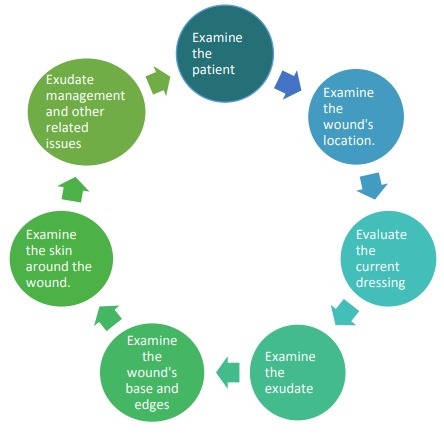Wound Exudate Identification and Management
The formation of exudate by open wounds is required for moist wound healing.
INTRODUCTION
The formation of exudate by open wounds is required for moist wound healing. However, when wounds create little or excessive exudate, or when the exudate’s composition is toxic, a variety of issues can arise, delaying healing, distressing patients, and using significant healthcare resources.
WHAT IS EXUDATE?
- Fluid coming from a wound is known as exudate. It is crucial in the healing process. Due to constriction of blood vessels, it is released during the ‘inflammatory phase’ of wound healing. Wound exudate aids wound healing by providing a moist environment, as well as necessary nutrients that nourish the tissues on the wound’s surface. It also aids in the reduction of infection rates and the discomfort associated with wounds.
- Exudate primarily consists of water, but it also contains electrolytes, nutrients, proteins, inflammatory mediators, protein digesting enzymes (e.g., matrix metalloproteinases (MMPs)), growth factors, and waste products, as well as various types of cells (e.g., neutrophils, macrophages, and platelets). TYPES OF WM,DIABETES FOOT PRESSURE SORE,SURGICAL WOUND MANAGEMENT
WHAT IS EXUDATE?
- Fluid coming from a wound is known as exudate. It is crucial in the healing process. Due to constriction of blood vessels, it is released during the ‘inflammatory phase’ of wound healing. Wound exudate aids wound healing by providing a moist environment, as well as necessary nutrients that nourish the tissues on the wound’s surface. It also aids in the reduction of infection rates and the discomfort associated with wounds.
- Exudate primarily consists of water, but it also contains electrolytes, nutrients, proteins, inflammatory mediators, protein digesting enzymes (e.g., matrix metalloproteinases (MMPs)), growth factors, and waste products, as well as various types of cells (e.g., neutrophils, macrophages, and platelets). TYPES OF WM,DIABETES FOOT PRESSURE SORE,SURGICAL WOUND MANAGEMENT
WHAT FACTORS INFLUENCE THE RATE AT WHICH EXUDATE IS PRODUCED?
- It’s crucial to remember that the volume of exudate is proportional to the wound’s surface area, therefore bigger wounds like burns, venous leg ulcers, and skin donor sites tend to produce more exudate.
- For optimal wound healing, a moist wound environment is needed, much or insufficient exudate production can cause problems on the healing process.
- When there is too much or too little exudate produced, it is critical that the healthcare provider precisely recognises and examines the elements that are causing the problem. Only then would it be possible to implement successful management techniques.
WHY CAN EXUDATE SOMETIMES CAUSE PROBLEMS WITH HEALING?
- Slows or even stops cell proliferation
- Interferes with the availability of growth factors
- Contains high levels of inflammatory mediators and activated MMPs
- Chronic wound exudate’s enhanced proteolytic activity has been linked to wound recurrence, wound bed damage, extracellular matrix degradation, and peri wound skin issues.
- Changes in exudate properties, such as color, amount, odor, or consistency, may have a special significance in exudate management.
WHY IS IT ESSENTIAL TO CONTROL EXUDATE?
- Exudate management that is effective can shorten the time it takes for a wound to heal,
- Eliminate exudate-related concerns such peri wound skin damage and infection, and improve patients’ quality of life.
- Reduced clothing changes, improved quality of life
- Inputs from clinicians and frequency
TYPE OF EXUDATE?
Serous exudate:
A clear, thin and watery plasma
Serosanguineous:
Thin, watery and pale red to pink in colour.
Sanguineous:
Bright red: indicates active bleeding
Purulent:
Thick, yellow, pale green, or white: indicates infection
HOW CAN YOU TELL IF YOUR EXUDATE ISN'T BEING CONTROLLED PROPERLY?
- Soiling and leaking
- Skin changes around the wound, such as maceration and denudation
- Smell discomfort/pain infection delayed healing
- Electrolyte and protein loss/fluid imbalance
- Need for frequent dressing changes
- Exudate-related leaking, soiling, odor, pain, and the need for frequent dressing changes can all be stressful for patients and caregivers, and can lead to social isolation
EXUDATE ASSESSMENT


